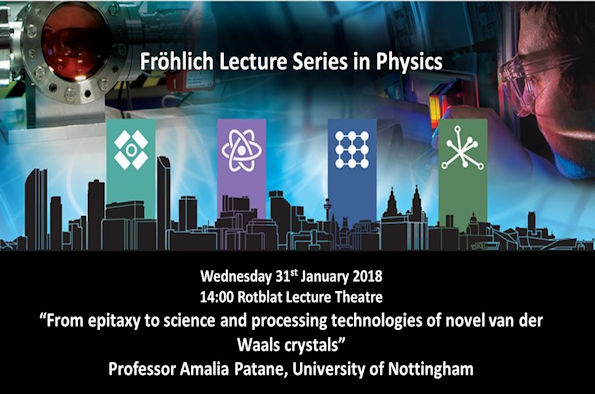
From epitaxy to science and processing technologies of novel van der Waals crystals - Professor Amalia Patane, University of Nottingham
- 0151 794 3358
- Mrs Angela Reid
- Suitable for: The Fröhlich Lectures are presentations by research leaders which are intended to be accessible to a general audience at the advanced undergraduate level.
- Admission: Free. Sandwiches/Refreshments will be served at 13.45 outside the lecture theatre
Add this event to my calendar
Click on "Create a calendar file" and your browser will download a .ics file for this event.
Microsoft Outlook: Download the file, double-click it to open it in Outlook, then click on "Save & Close" to save it to your calendar. If that doesn't work go into Outlook, click on the File tab, then on Open & Export, then Open Calendar. Select your .ics file then click on "Save & Close".
Google Calendar: download the file, then go into your calendar. On the left where it says "Other calendars" click on the arrow icon and then click on Import calendar. Click on Browse and select the .ics file, then click on Import.
Apple Calendar: The file may open automatically with an option to save it to your calendar. If not, download the file, then you can either drag it to Calendar or import the file by going to File >Import > Import and choosing the .ics file.
References
1. G.W. Mudd et al., Advanced Materials 25, 5714 (2013); ibidem 27, 3760 (2015).
2. G.W. Mudd et al., Scientific Reports 6, 39619 (2016).
3. N. Balakrishnan et al. 2D Materials 4, 25043 (2017).
4. D.A. Bandurin et al. Nature Nanotechnology 12, 223, (2017).
5. Z.R. Kudrynskyi et al. Physical Review Letters 119, 157701 (2017).
Prof Amalia Patanè studied at the University of Rome “La Sapienza” where she graduated with first-class honours in Physics in 1994 followed by a PhD degree in 1998. She has worked as a Research Associate (1998-2002) in the School of Physics and Astronomy of the University of Nottingham, where she conducted the first imaging by magneto-tunneling of electrons confined in a nanocrystal (Science 2000). As a lecturer at Nottingham (2002-06), she has developed further her research on quantum systems by exploring novel carrier dynamics in high magnetic fields (Nature 2004). She was promoted Reader in 2006 and Professor of Physics in 2011. Her current research focuses on novel van der Waals two dimensional crystals (Nature Nanotechnology 2017; Physical Review Letters 2017).
Prof. Patanè leads the University of Nottingham in the EU Graphene Flagship and as a member of the Council of the European Magnetic Field Laboratory, EMFL, she promotes the development of high magnetic field facilities and their application to study important materials in condensed matter physics. Her research achievements were recognized by the Sir Charles Vernon Boys Medal and Prize of the Institute of Physics (2007), an EPSRC Advanced Research Fellowship (2004-09), and a Leverhulme Trust Research Fellowship (2017-19). She is also a Member of the International Union of Pure and Applied Physics Commission (IUPAP, Semiconductor Commission 2014-20) and the Council Board of the EMFL (2015-20).
